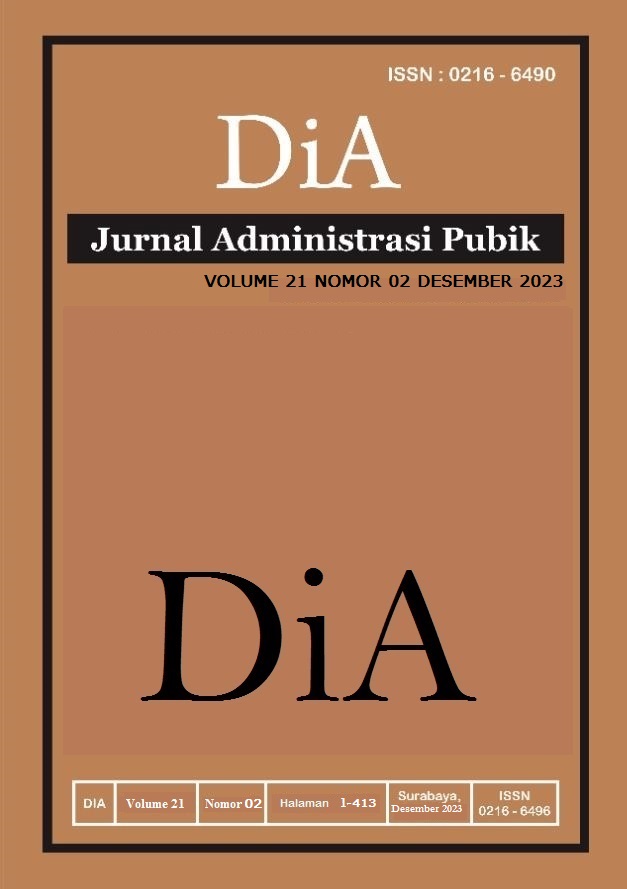IMPORTANCE-PERFORMANCE ANALYSIS OF PT PELINDO TERMINAL PETIKEMAS' CORPORATE IMAGE
Abstract
Corporate image is an important factor that can affect the performance of a company. PT Pelindo Terminal Petikemas (SPTP) is one of the subholdings of PT Pelindo that operates the container terminal business in Indonesia. This study aims to identify the factors of corporate image that are important to stakeholders and how PT SPTP performs in meeting those factors. The study used the importance-performance analysis (IPA) method with a questionnaire as the data collection instrument. The respondents were internal stakeholders (structural employees, non-structural employees, and shareholders) and external stakeholders (academics, members of the DPR RI, relevant associations, customers, government agencies, journalists, partner companies, CSR recipients, and vendors). The results of the study showed that the factors of corporate image that are important to PT SPTP stakeholders are: Company reputation, Business ethics, Social and environmental responsibility, Positive feelings, Usefulness, PT SPTP has met most of these factors. However, there are still some factors that need to be improved, namely: Communication of social and environmental responsibility, and Communication of company activities. This study is expected to provide information to PT SPTP to improve its corporate image.
Downloads
References
Balmer, J. M. T., Lin, Z., Chen, W., & He, X. (2020). The role of corporate brand image for B2B relationships of logistics service providers in China. Journal of Business Research, 117(March), 850–861. https://doi.org/10.1016/j.jbusres.2020.03.043
Gray, E. R., & Balmer, J. M. T. (1998). Managing Corporate Image and Corporate Reputation. Long Range Planning, 31(5), 695–702. https://doi.org/10.1016/S0024-6301(98)00074-0
Hafez, M. (2018). Measuring the impact of corporate social responsibility practices on brand equity in the banking industry in Bangladesh: The mediating effect of corporate image and brand awareness. International Journal of Bank Marketing, 36(5), 806–822. https://doi.org/10.1108/IJBM-04-2017-0072
Jasfar, F. (2005). Manajemen Jasa Pendekatan Terpadu (First Edit). Ghalia.
Kandampully, J., & Suhartanto, D. (2000). Customer loyalty in the hotel industry: The role of customer satisfaction and image. International Journal of Contemporary Hospitality Management, 12(6), 346–351. https://doi.org/10.1108/09596110010342559
Keller, K. L. (1993). Conceptualizing, measuring, managing. Journal of Marketing, 57, 1–22.
Mardalis, A. (2005). Meraih loyalitas pelanggan. balai pustaka.
Petikemas, P. T. (2024). Tentang Kami Pelindo Terminal Petikemas. https://www.pelindotpk.co.id/id/vision-mission
Purwanto, E., Deviny, J., & Mutahar, A. M. (2020). The Mediating Role of Trust in the Relationship between Corporate Image, Security, Word of Mouth and Loyalty in M-Banking Using among the Millennial Generation in Indonesia. Management and Marketing, 15(2), 255–274. https://doi.org/10.2478/mmcks-2020-0016
Saputra, F., & Sumantyo, F. D. S. (2022). The Role of Marketing Management in Information Industry: Corporate Image, Brand Awareness and Promotion (Case Study at PT Lensa Potret Mandiri). Journal of Applied Management and Business (JAMB), 3(2), 46–54. https://doi.org/10.37802/jamb.v3i2.267
Soelistiawan, H., Lukitaningsih, A., & Wiyono, G. (2021). Pentingnya Trust dalam Mediasi Citra Perusahaan dan Relationship marketing Terhadap Loyalitas Pelanggan. Jurnal Bisnis Dan Manajemen, 8(1), 188–196. http://jurnal.unmer.ac.id/index.php/jbm/index
Sugiyono. (2017). Metode Penelitian Pendidikan Pendekatan Kuantitatif, Kualitatif, dan R&D. Alfabeta.
Supranto, J. (2011). Pengukuran Tingkat Kepuasan Customer Untuk Menaikan Pangsa Pasar. Rineka Cipta.
Widiastuti, P., & Trianaasari. (2020). Pengaruh Corporate Image Dan Kepuasan Pelanggan Terhadap Loyalitas Pelanggan Di Hotel the Lovina Bali. Jurnal Manajemen, 6(2), 150–158.
Yu, W., Han, X., Ding, L., & He, M. (2020). Organic food corporate image and customer co-developing behavior: The mediating role of consumer trust and purchase intention. Journal of Retailing and Consumer Services, 59(April), 102377. https://doi.org/10.1016/j.jretconser.2020.102377
Copyright (c) 2023 Nugraha Kusbianto, Ute Chairuz M. Nasution, V. Rudy Handoko, Ayun Maduwinarti (Author)

This work is licensed under a Creative Commons Attribution-ShareAlike 4.0 International License.
The DiA journal allows authors to retain the copyright of their papers without limitation. Authors may grant publishers non-exclusive publishing rights to publish articles. Granting first publishing rights to publishers also qualifies as unlimited copyright (because there are no restrictions imposed by publishers on author copyright).










